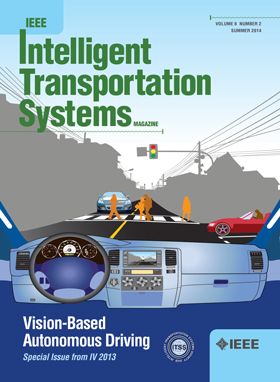无车道交通中多辆自动驾驶车辆的联合路径规划与车辆导航
IF 7.9
1区 工程技术
Q1 ENGINEERING, CIVIL
IEEE Transactions on Intelligent Transportation Systems
Pub Date : 2024-08-30
DOI:10.1109/TITS.2024.3445501
引用次数: 0
摘要
本文提出了一种联合轨迹优化算法,适用于无车道交通环境中的多辆互联自动驾驶车辆,并具有车辆推移功能。每辆车的纵向和横向运动均采用双双积分器模型。目标函数由多个子目标组成,这些子目标反映了相应的、部分相互竞争的驾驶方面和关注点,包括乘客舒适度、低油耗、车辆以预期速度前进、避免碰撞、抑制不可行的机动操作。固定的和与状态相关的控制输入边界考虑了各种技术限制以及道路边界。利用非常高效的可行方向算法计算所制定的联合最优控制问题(OCP)的解决方案,该算法利用状态方程的结构将 OCP 映射为一个简化的非线性编程问题。为了证明所提方法的效率,我们在一条无车道的笔直高速公路上对具有挑战性的场景进行了研究。集中式(联合)OCP 的结果与之前研究的分散式方法进行了比较,后者对单个车辆分别采用 OCP。本文章由计算机程序翻译,如有差异,请以英文原文为准。
Joint Path Planning for Multiple Automated Vehicles in Lane-Free Traffic With Vehicle Nudging
This article presents a joint trajectory optimization algorithm for a number of connected and automated vehicles in a lane-free traffic environment with vehicle nudging. A double double-integrator model is utilized for the longitudinal and lateral movements of each vehicle. The objective function consists of several sub-objectives that reflect corresponding, partially competing driving aspects and concerns, including passenger comfort, low fuel consumption, vehicle advancing at desired speed, collision avoidance, suppressing of infeasible maneuvers. Fixed and state-dependent control input bounds account for various technical limitations as well as for road boundary respect. The solution of the formulated joint Optimal Control Problem (OCP) is computed by use of a very efficient Feasible Direction Algorithm, which exploits the structure of the state equations to map the OCP into a reduced Nonlinear Programming Problem. To demonstrate the efficiency of the proposed approach, challenging scenarios are examined on a lane-free straight motorway stretch. The results of the centralized (joint) OCP are compared with a previously investigated decentralized approach where OCPs are employed separately for individual vehicles.
求助全文
通过发布文献求助,成功后即可免费获取论文全文。
去求助
来源期刊

IEEE Transactions on Intelligent Transportation Systems
工程技术-工程:电子与电气
CiteScore
14.80
自引率
12.90%
发文量
1872
审稿时长
7.5 months
期刊介绍:
The theoretical, experimental and operational aspects of electrical and electronics engineering and information technologies as applied to Intelligent Transportation Systems (ITS). Intelligent Transportation Systems are defined as those systems utilizing synergistic technologies and systems engineering concepts to develop and improve transportation systems of all kinds. The scope of this interdisciplinary activity includes the promotion, consolidation and coordination of ITS technical activities among IEEE entities, and providing a focus for cooperative activities, both internally and externally.
 求助内容:
求助内容: 应助结果提醒方式:
应助结果提醒方式:


